IT and POS System Analysis: Advantages, Disadvantages, and Risks
VerifiedAdded on 2021/06/14
|10
|2144
|33
Report
AI Summary
This report provides a comprehensive analysis of the Point of Sale (POS) system within the context of Information Technology in Business. It begins with an abstract highlighting the importance of IT in modern business operations and the benefits of information systems. The report delves into the advantages and disadvantages of POS systems, emphasizing the management of business data, decision-making capabilities, and potential drawbacks like single points of failure and security vulnerabilities. It then explores the competitive edge POS systems offer, including cost transformation, differentiation, and innovation. Further, it discusses the advantages of a centralized database in terms of data integrity and security, and how POS systems facilitate better decision-making. Telecommunication options, including LAN and WAN, along with wired and wireless technologies, are also examined. The report concludes by addressing the risks associated with POS systems, particularly concerning data security and privacy, and suggests mitigation strategies. The analysis is supported by references to academic sources and industry publications.
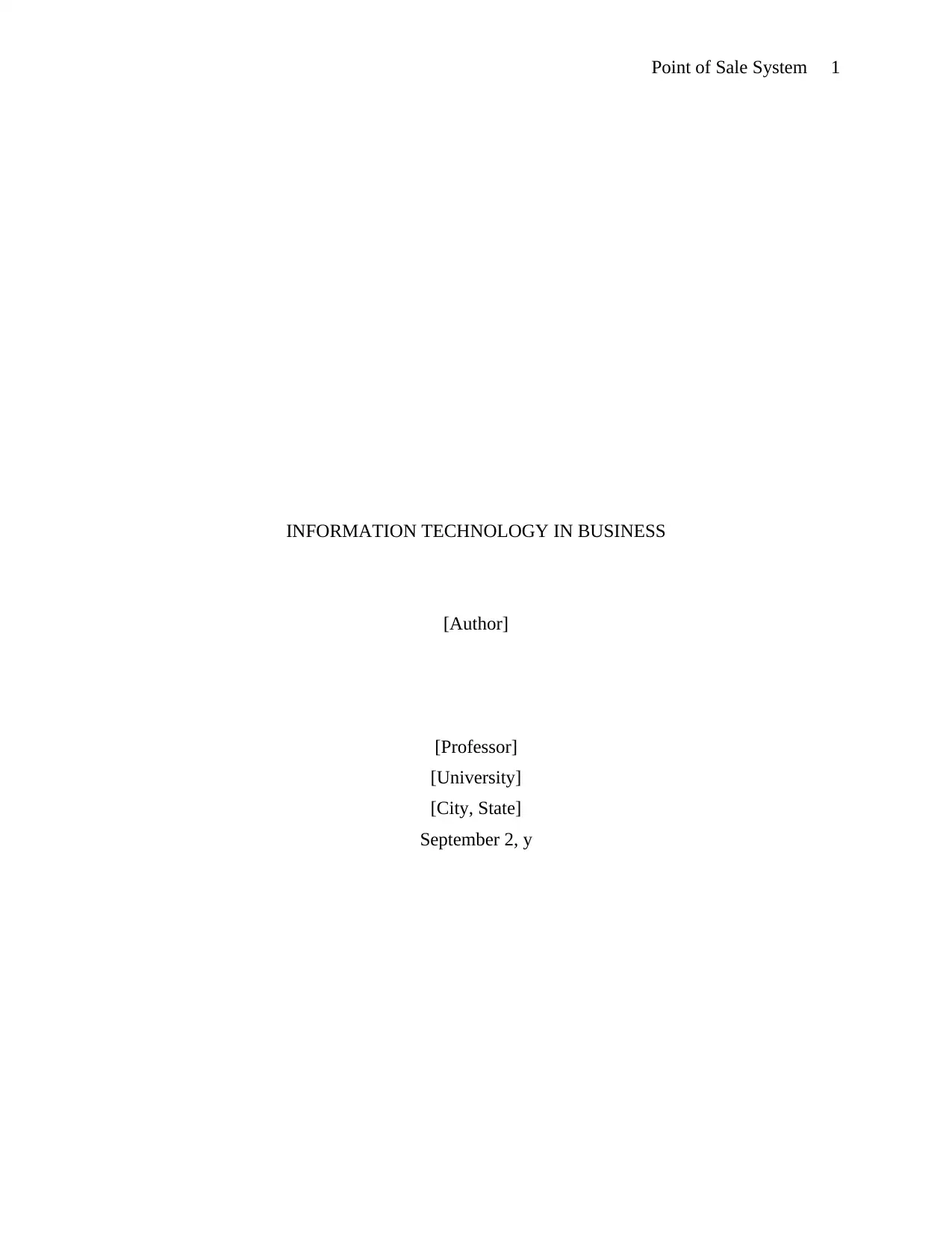
Point of Sale System 1
INFORMATION TECHNOLOGY IN BUSINESS
[Author]
[Professor]
[University]
[City, State]
September 2, y
INFORMATION TECHNOLOGY IN BUSINESS
[Author]
[Professor]
[University]
[City, State]
September 2, y
Paraphrase This Document
Need a fresh take? Get an instant paraphrase of this document with our AI Paraphraser
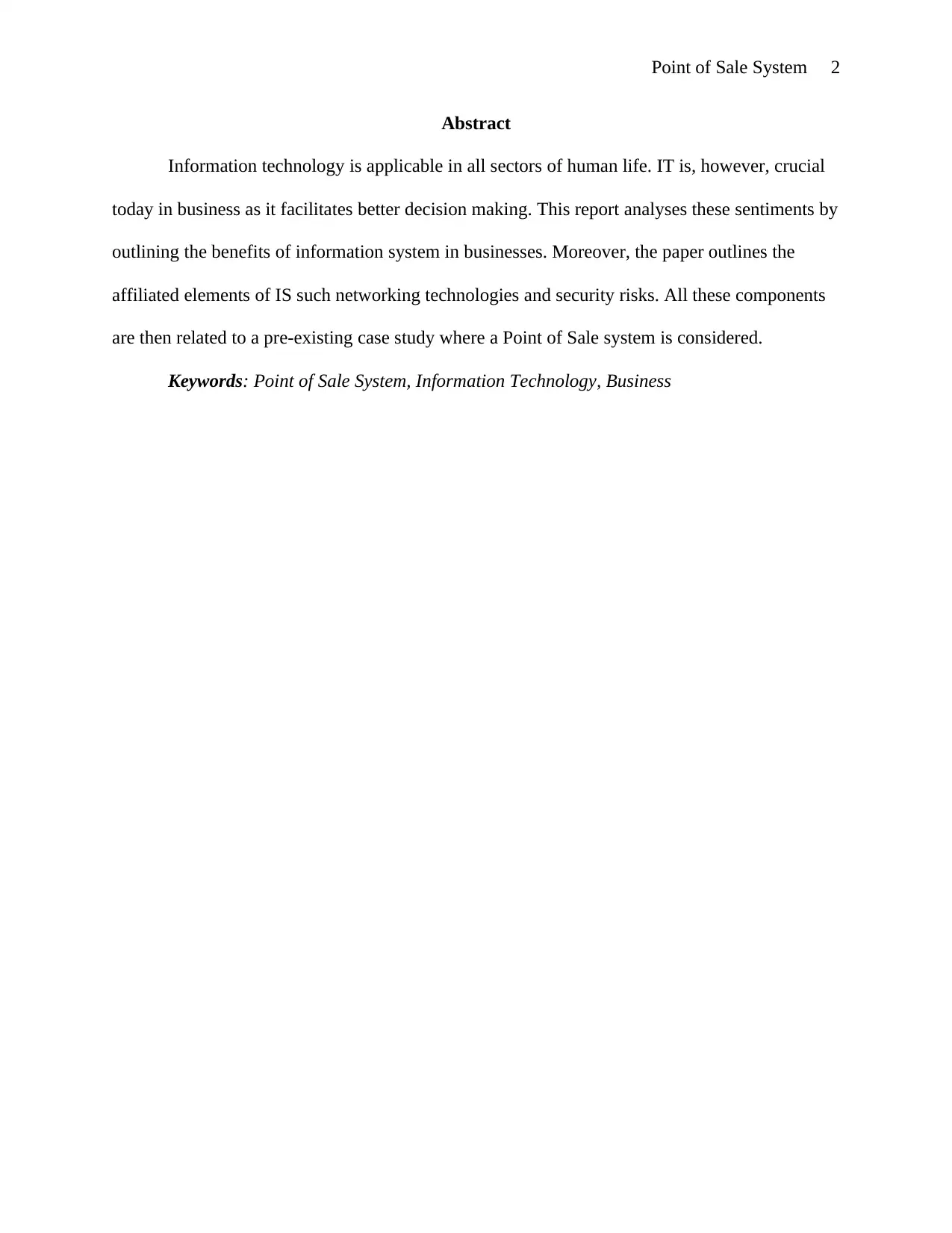
Point of Sale System 2
Abstract
Information technology is applicable in all sectors of human life. IT is, however, crucial
today in business as it facilitates better decision making. This report analyses these sentiments by
outlining the benefits of information system in businesses. Moreover, the paper outlines the
affiliated elements of IS such networking technologies and security risks. All these components
are then related to a pre-existing case study where a Point of Sale system is considered.
Keywords: Point of Sale System, Information Technology, Business
Abstract
Information technology is applicable in all sectors of human life. IT is, however, crucial
today in business as it facilitates better decision making. This report analyses these sentiments by
outlining the benefits of information system in businesses. Moreover, the paper outlines the
affiliated elements of IS such networking technologies and security risks. All these components
are then related to a pre-existing case study where a Point of Sale system is considered.
Keywords: Point of Sale System, Information Technology, Business
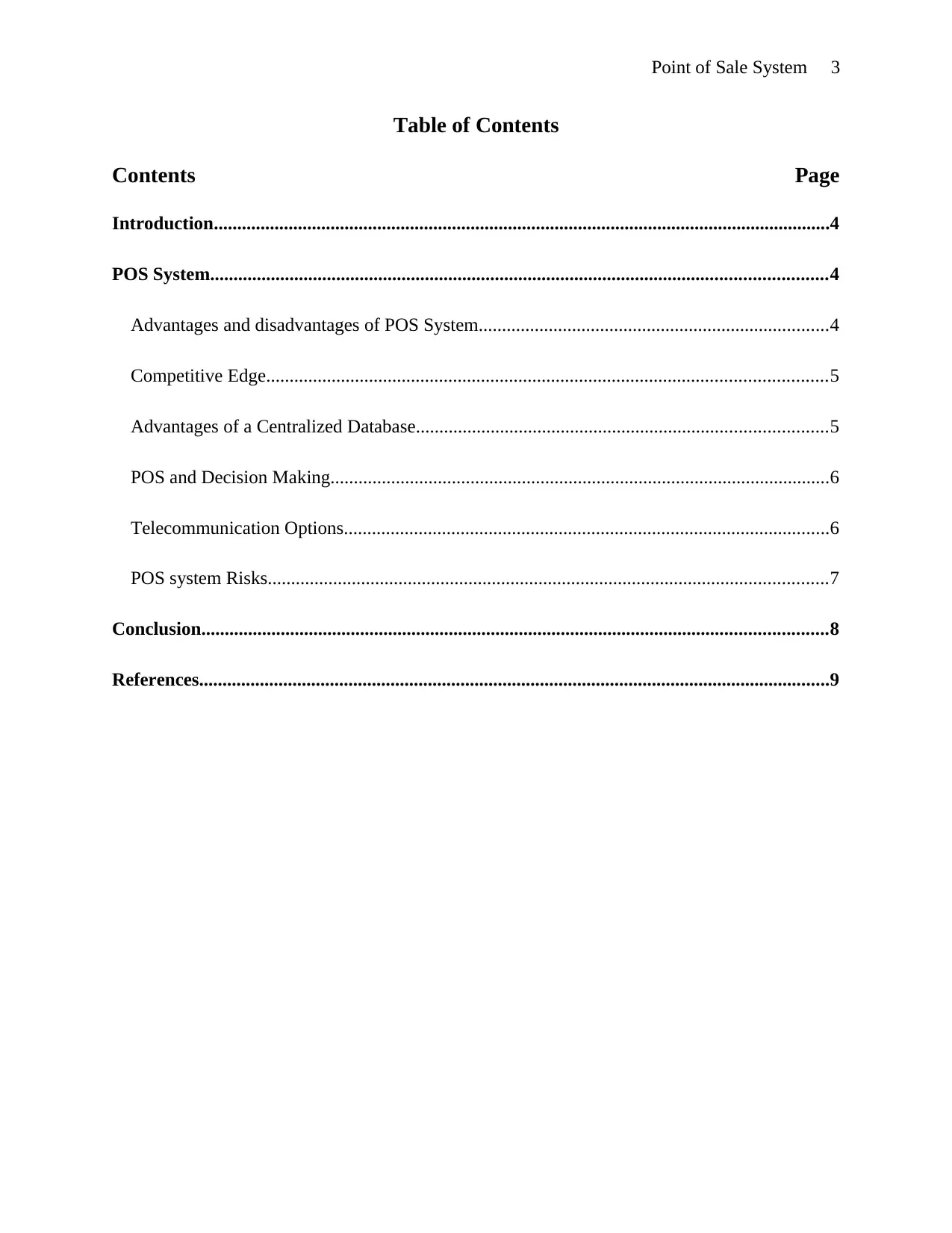
Point of Sale System 3
Table of Contents
Contents Page
Introduction....................................................................................................................................4
POS System....................................................................................................................................4
Advantages and disadvantages of POS System...........................................................................4
Competitive Edge........................................................................................................................5
Advantages of a Centralized Database........................................................................................5
POS and Decision Making...........................................................................................................6
Telecommunication Options........................................................................................................6
POS system Risks........................................................................................................................7
Conclusion......................................................................................................................................8
References.......................................................................................................................................9
Table of Contents
Contents Page
Introduction....................................................................................................................................4
POS System....................................................................................................................................4
Advantages and disadvantages of POS System...........................................................................4
Competitive Edge........................................................................................................................5
Advantages of a Centralized Database........................................................................................5
POS and Decision Making...........................................................................................................6
Telecommunication Options........................................................................................................6
POS system Risks........................................................................................................................7
Conclusion......................................................................................................................................8
References.......................................................................................................................................9
⊘ This is a preview!⊘
Do you want full access?
Subscribe today to unlock all pages.

Trusted by 1+ million students worldwide
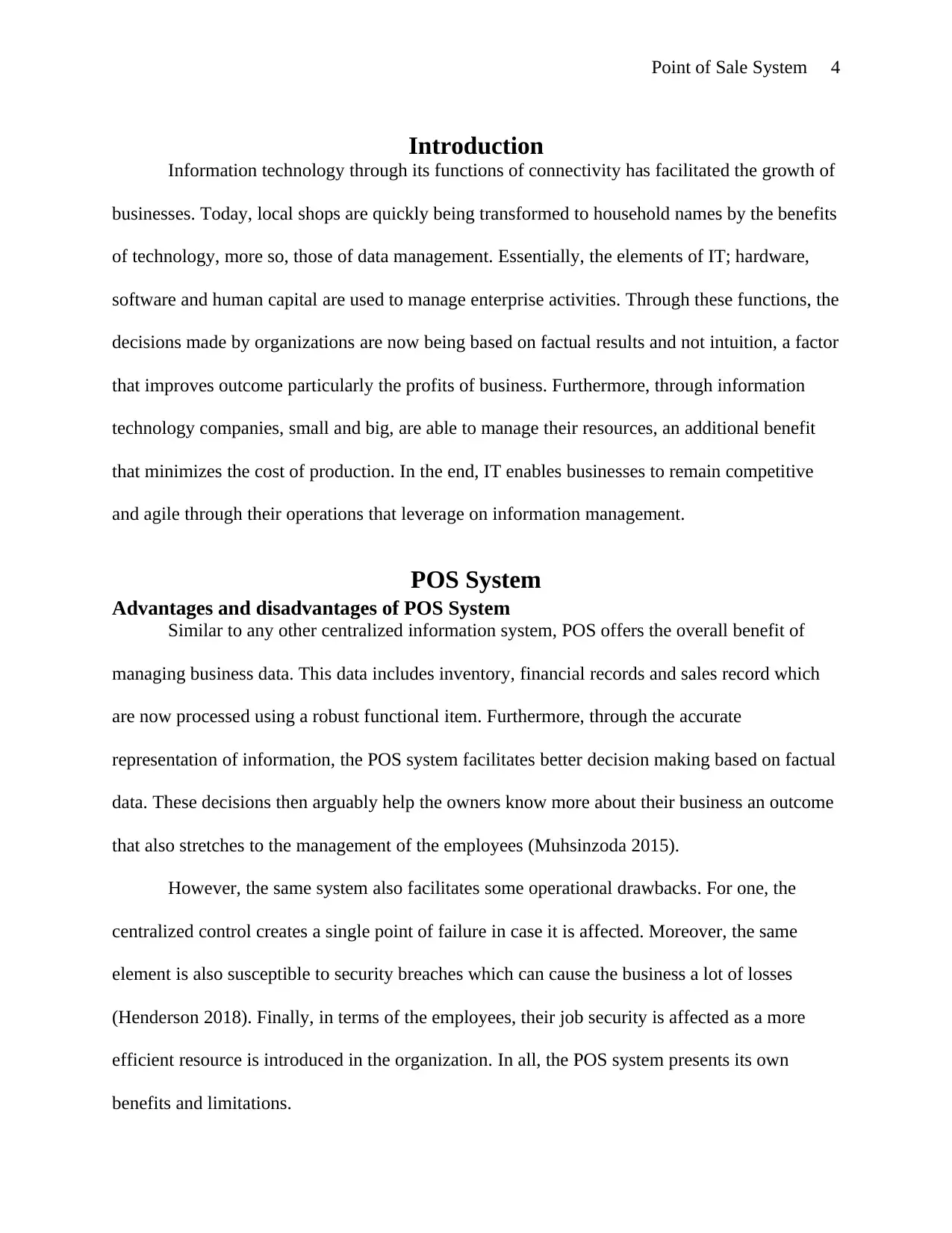
Point of Sale System 4
Introduction
Information technology through its functions of connectivity has facilitated the growth of
businesses. Today, local shops are quickly being transformed to household names by the benefits
of technology, more so, those of data management. Essentially, the elements of IT; hardware,
software and human capital are used to manage enterprise activities. Through these functions, the
decisions made by organizations are now being based on factual results and not intuition, a factor
that improves outcome particularly the profits of business. Furthermore, through information
technology companies, small and big, are able to manage their resources, an additional benefit
that minimizes the cost of production. In the end, IT enables businesses to remain competitive
and agile through their operations that leverage on information management.
POS System
Advantages and disadvantages of POS System
Similar to any other centralized information system, POS offers the overall benefit of
managing business data. This data includes inventory, financial records and sales record which
are now processed using a robust functional item. Furthermore, through the accurate
representation of information, the POS system facilitates better decision making based on factual
data. These decisions then arguably help the owners know more about their business an outcome
that also stretches to the management of the employees (Muhsinzoda 2015).
However, the same system also facilitates some operational drawbacks. For one, the
centralized control creates a single point of failure in case it is affected. Moreover, the same
element is also susceptible to security breaches which can cause the business a lot of losses
(Henderson 2018). Finally, in terms of the employees, their job security is affected as a more
efficient resource is introduced in the organization. In all, the POS system presents its own
benefits and limitations.
Introduction
Information technology through its functions of connectivity has facilitated the growth of
businesses. Today, local shops are quickly being transformed to household names by the benefits
of technology, more so, those of data management. Essentially, the elements of IT; hardware,
software and human capital are used to manage enterprise activities. Through these functions, the
decisions made by organizations are now being based on factual results and not intuition, a factor
that improves outcome particularly the profits of business. Furthermore, through information
technology companies, small and big, are able to manage their resources, an additional benefit
that minimizes the cost of production. In the end, IT enables businesses to remain competitive
and agile through their operations that leverage on information management.
POS System
Advantages and disadvantages of POS System
Similar to any other centralized information system, POS offers the overall benefit of
managing business data. This data includes inventory, financial records and sales record which
are now processed using a robust functional item. Furthermore, through the accurate
representation of information, the POS system facilitates better decision making based on factual
data. These decisions then arguably help the owners know more about their business an outcome
that also stretches to the management of the employees (Muhsinzoda 2015).
However, the same system also facilitates some operational drawbacks. For one, the
centralized control creates a single point of failure in case it is affected. Moreover, the same
element is also susceptible to security breaches which can cause the business a lot of losses
(Henderson 2018). Finally, in terms of the employees, their job security is affected as a more
efficient resource is introduced in the organization. In all, the POS system presents its own
benefits and limitations.
Paraphrase This Document
Need a fresh take? Get an instant paraphrase of this document with our AI Paraphraser
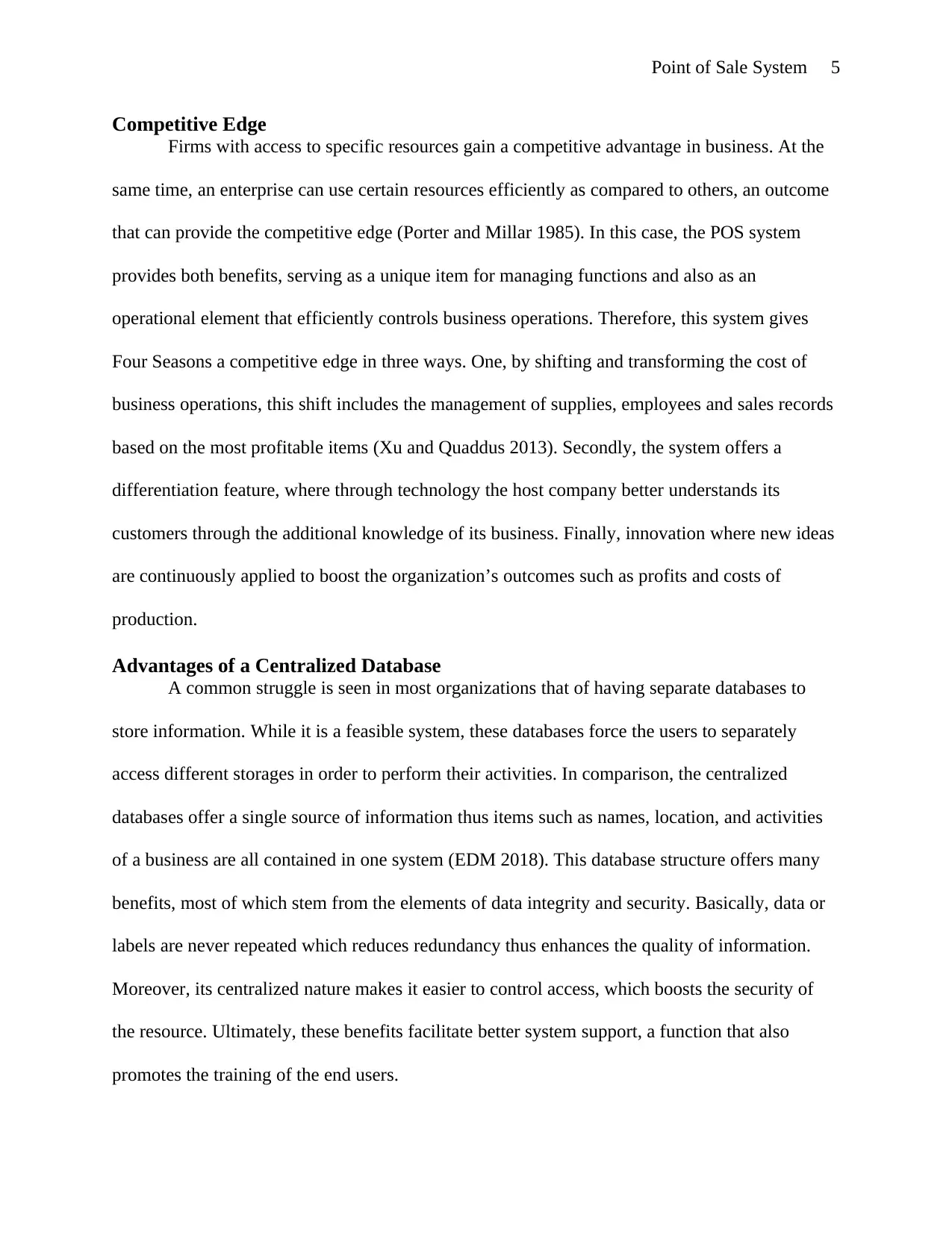
Point of Sale System 5
Competitive Edge
Firms with access to specific resources gain a competitive advantage in business. At the
same time, an enterprise can use certain resources efficiently as compared to others, an outcome
that can provide the competitive edge (Porter and Millar 1985). In this case, the POS system
provides both benefits, serving as a unique item for managing functions and also as an
operational element that efficiently controls business operations. Therefore, this system gives
Four Seasons a competitive edge in three ways. One, by shifting and transforming the cost of
business operations, this shift includes the management of supplies, employees and sales records
based on the most profitable items (Xu and Quaddus 2013). Secondly, the system offers a
differentiation feature, where through technology the host company better understands its
customers through the additional knowledge of its business. Finally, innovation where new ideas
are continuously applied to boost the organization’s outcomes such as profits and costs of
production.
Advantages of a Centralized Database
A common struggle is seen in most organizations that of having separate databases to
store information. While it is a feasible system, these databases force the users to separately
access different storages in order to perform their activities. In comparison, the centralized
databases offer a single source of information thus items such as names, location, and activities
of a business are all contained in one system (EDM 2018). This database structure offers many
benefits, most of which stem from the elements of data integrity and security. Basically, data or
labels are never repeated which reduces redundancy thus enhances the quality of information.
Moreover, its centralized nature makes it easier to control access, which boosts the security of
the resource. Ultimately, these benefits facilitate better system support, a function that also
promotes the training of the end users.
Competitive Edge
Firms with access to specific resources gain a competitive advantage in business. At the
same time, an enterprise can use certain resources efficiently as compared to others, an outcome
that can provide the competitive edge (Porter and Millar 1985). In this case, the POS system
provides both benefits, serving as a unique item for managing functions and also as an
operational element that efficiently controls business operations. Therefore, this system gives
Four Seasons a competitive edge in three ways. One, by shifting and transforming the cost of
business operations, this shift includes the management of supplies, employees and sales records
based on the most profitable items (Xu and Quaddus 2013). Secondly, the system offers a
differentiation feature, where through technology the host company better understands its
customers through the additional knowledge of its business. Finally, innovation where new ideas
are continuously applied to boost the organization’s outcomes such as profits and costs of
production.
Advantages of a Centralized Database
A common struggle is seen in most organizations that of having separate databases to
store information. While it is a feasible system, these databases force the users to separately
access different storages in order to perform their activities. In comparison, the centralized
databases offer a single source of information thus items such as names, location, and activities
of a business are all contained in one system (EDM 2018). This database structure offers many
benefits, most of which stem from the elements of data integrity and security. Basically, data or
labels are never repeated which reduces redundancy thus enhances the quality of information.
Moreover, its centralized nature makes it easier to control access, which boosts the security of
the resource. Ultimately, these benefits facilitate better system support, a function that also
promotes the training of the end users.
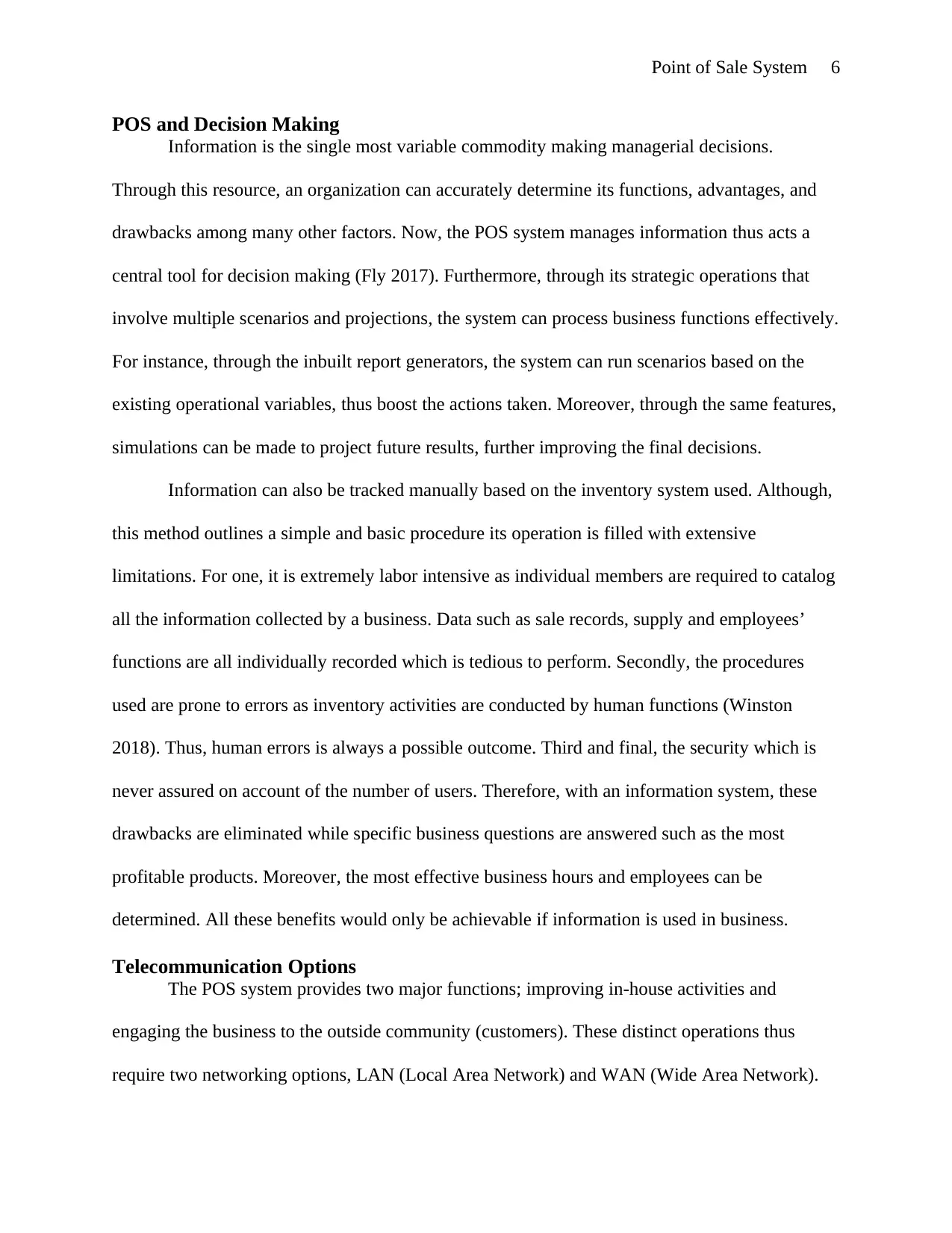
Point of Sale System 6
POS and Decision Making
Information is the single most variable commodity making managerial decisions.
Through this resource, an organization can accurately determine its functions, advantages, and
drawbacks among many other factors. Now, the POS system manages information thus acts a
central tool for decision making (Fly 2017). Furthermore, through its strategic operations that
involve multiple scenarios and projections, the system can process business functions effectively.
For instance, through the inbuilt report generators, the system can run scenarios based on the
existing operational variables, thus boost the actions taken. Moreover, through the same features,
simulations can be made to project future results, further improving the final decisions.
Information can also be tracked manually based on the inventory system used. Although,
this method outlines a simple and basic procedure its operation is filled with extensive
limitations. For one, it is extremely labor intensive as individual members are required to catalog
all the information collected by a business. Data such as sale records, supply and employees’
functions are all individually recorded which is tedious to perform. Secondly, the procedures
used are prone to errors as inventory activities are conducted by human functions (Winston
2018). Thus, human errors is always a possible outcome. Third and final, the security which is
never assured on account of the number of users. Therefore, with an information system, these
drawbacks are eliminated while specific business questions are answered such as the most
profitable products. Moreover, the most effective business hours and employees can be
determined. All these benefits would only be achievable if information is used in business.
Telecommunication Options
The POS system provides two major functions; improving in-house activities and
engaging the business to the outside community (customers). These distinct operations thus
require two networking options, LAN (Local Area Network) and WAN (Wide Area Network).
POS and Decision Making
Information is the single most variable commodity making managerial decisions.
Through this resource, an organization can accurately determine its functions, advantages, and
drawbacks among many other factors. Now, the POS system manages information thus acts a
central tool for decision making (Fly 2017). Furthermore, through its strategic operations that
involve multiple scenarios and projections, the system can process business functions effectively.
For instance, through the inbuilt report generators, the system can run scenarios based on the
existing operational variables, thus boost the actions taken. Moreover, through the same features,
simulations can be made to project future results, further improving the final decisions.
Information can also be tracked manually based on the inventory system used. Although,
this method outlines a simple and basic procedure its operation is filled with extensive
limitations. For one, it is extremely labor intensive as individual members are required to catalog
all the information collected by a business. Data such as sale records, supply and employees’
functions are all individually recorded which is tedious to perform. Secondly, the procedures
used are prone to errors as inventory activities are conducted by human functions (Winston
2018). Thus, human errors is always a possible outcome. Third and final, the security which is
never assured on account of the number of users. Therefore, with an information system, these
drawbacks are eliminated while specific business questions are answered such as the most
profitable products. Moreover, the most effective business hours and employees can be
determined. All these benefits would only be achievable if information is used in business.
Telecommunication Options
The POS system provides two major functions; improving in-house activities and
engaging the business to the outside community (customers). These distinct operations thus
require two networking options, LAN (Local Area Network) and WAN (Wide Area Network).
⊘ This is a preview!⊘
Do you want full access?
Subscribe today to unlock all pages.

Trusted by 1+ million students worldwide
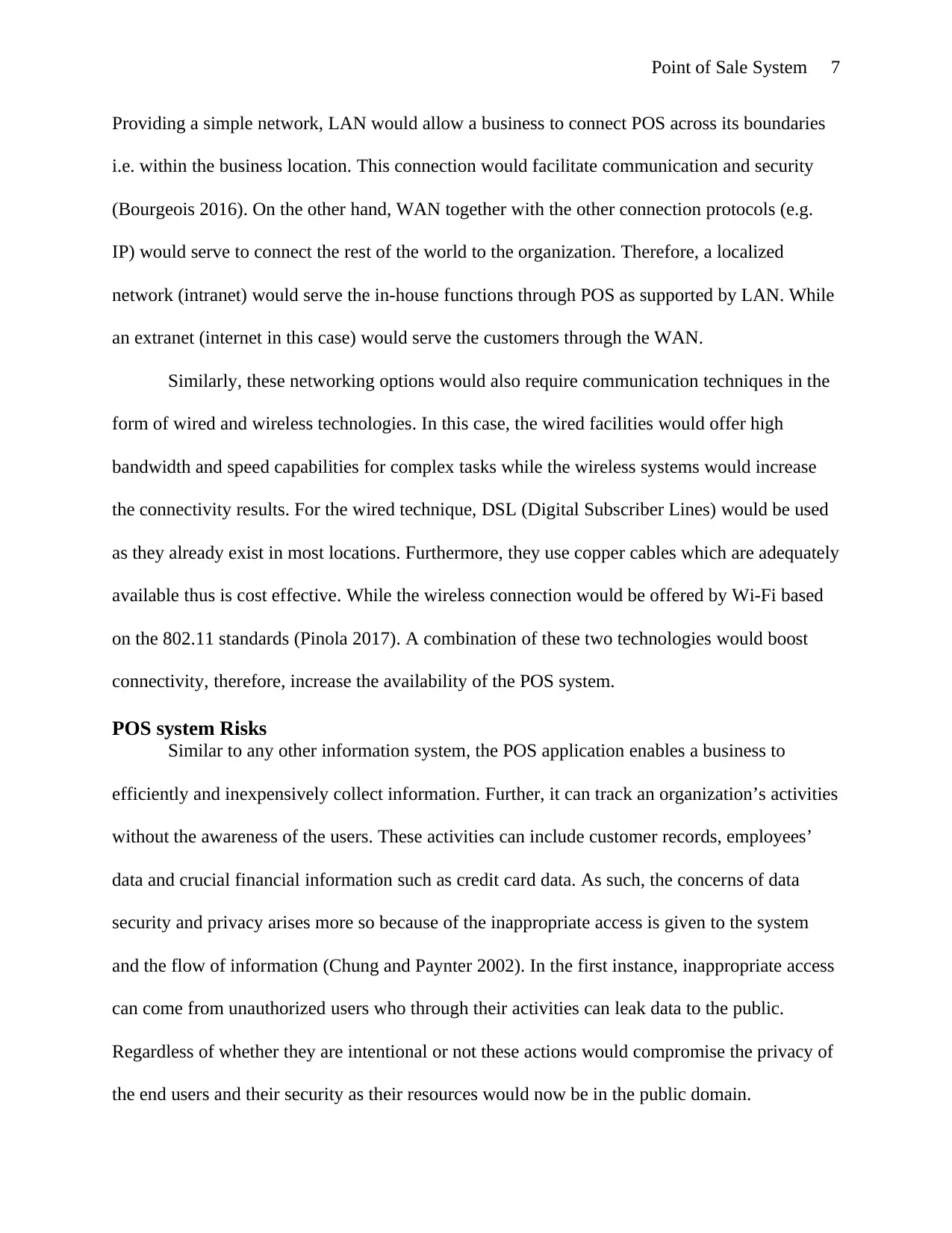
Point of Sale System 7
Providing a simple network, LAN would allow a business to connect POS across its boundaries
i.e. within the business location. This connection would facilitate communication and security
(Bourgeois 2016). On the other hand, WAN together with the other connection protocols (e.g.
IP) would serve to connect the rest of the world to the organization. Therefore, a localized
network (intranet) would serve the in-house functions through POS as supported by LAN. While
an extranet (internet in this case) would serve the customers through the WAN.
Similarly, these networking options would also require communication techniques in the
form of wired and wireless technologies. In this case, the wired facilities would offer high
bandwidth and speed capabilities for complex tasks while the wireless systems would increase
the connectivity results. For the wired technique, DSL (Digital Subscriber Lines) would be used
as they already exist in most locations. Furthermore, they use copper cables which are adequately
available thus is cost effective. While the wireless connection would be offered by Wi-Fi based
on the 802.11 standards (Pinola 2017). A combination of these two technologies would boost
connectivity, therefore, increase the availability of the POS system.
POS system Risks
Similar to any other information system, the POS application enables a business to
efficiently and inexpensively collect information. Further, it can track an organization’s activities
without the awareness of the users. These activities can include customer records, employees’
data and crucial financial information such as credit card data. As such, the concerns of data
security and privacy arises more so because of the inappropriate access is given to the system
and the flow of information (Chung and Paynter 2002). In the first instance, inappropriate access
can come from unauthorized users who through their activities can leak data to the public.
Regardless of whether they are intentional or not these actions would compromise the privacy of
the end users and their security as their resources would now be in the public domain.
Providing a simple network, LAN would allow a business to connect POS across its boundaries
i.e. within the business location. This connection would facilitate communication and security
(Bourgeois 2016). On the other hand, WAN together with the other connection protocols (e.g.
IP) would serve to connect the rest of the world to the organization. Therefore, a localized
network (intranet) would serve the in-house functions through POS as supported by LAN. While
an extranet (internet in this case) would serve the customers through the WAN.
Similarly, these networking options would also require communication techniques in the
form of wired and wireless technologies. In this case, the wired facilities would offer high
bandwidth and speed capabilities for complex tasks while the wireless systems would increase
the connectivity results. For the wired technique, DSL (Digital Subscriber Lines) would be used
as they already exist in most locations. Furthermore, they use copper cables which are adequately
available thus is cost effective. While the wireless connection would be offered by Wi-Fi based
on the 802.11 standards (Pinola 2017). A combination of these two technologies would boost
connectivity, therefore, increase the availability of the POS system.
POS system Risks
Similar to any other information system, the POS application enables a business to
efficiently and inexpensively collect information. Further, it can track an organization’s activities
without the awareness of the users. These activities can include customer records, employees’
data and crucial financial information such as credit card data. As such, the concerns of data
security and privacy arises more so because of the inappropriate access is given to the system
and the flow of information (Chung and Paynter 2002). In the first instance, inappropriate access
can come from unauthorized users who through their activities can leak data to the public.
Regardless of whether they are intentional or not these actions would compromise the privacy of
the end users and their security as their resources would now be in the public domain.
Paraphrase This Document
Need a fresh take? Get an instant paraphrase of this document with our AI Paraphraser
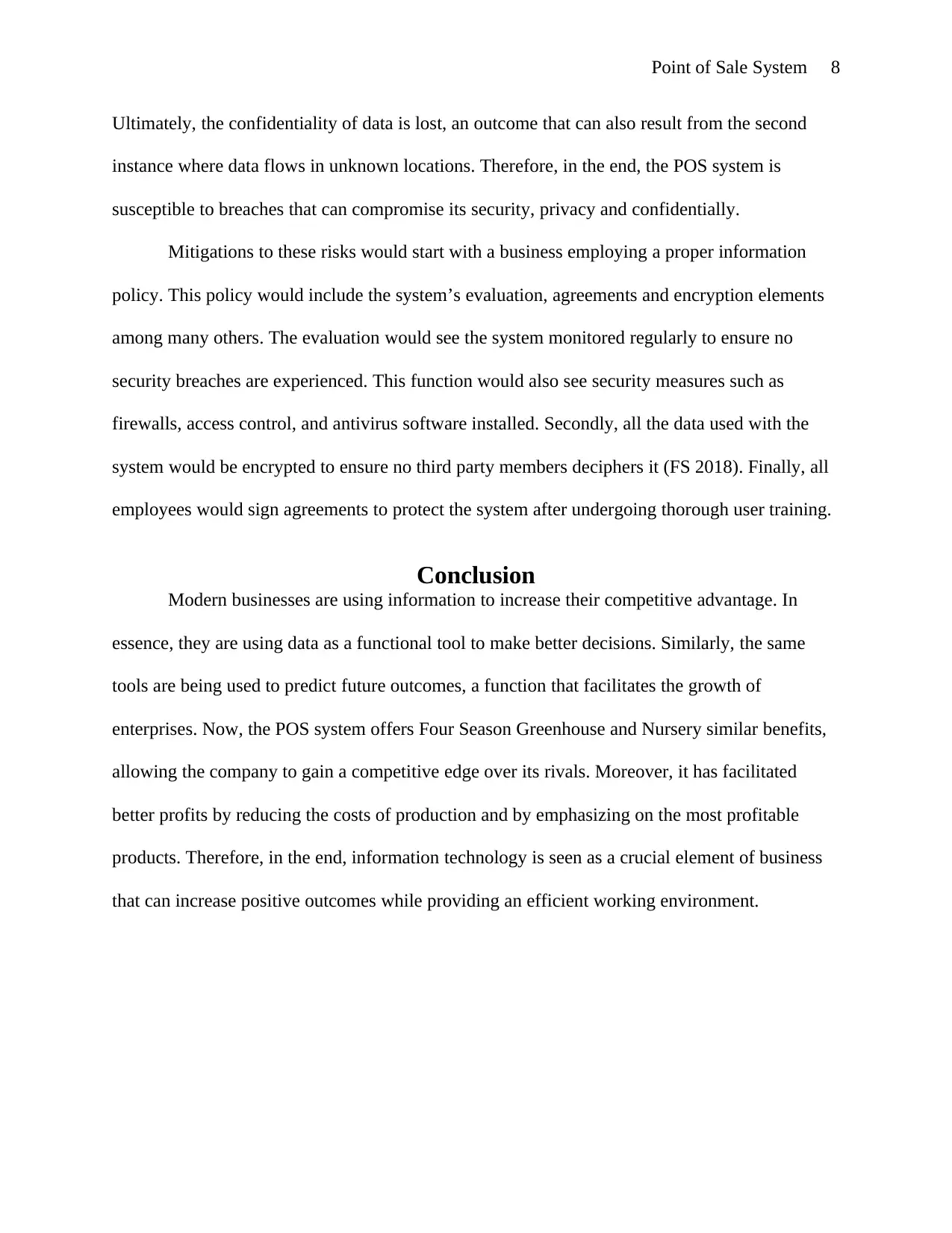
Point of Sale System 8
Ultimately, the confidentiality of data is lost, an outcome that can also result from the second
instance where data flows in unknown locations. Therefore, in the end, the POS system is
susceptible to breaches that can compromise its security, privacy and confidentially.
Mitigations to these risks would start with a business employing a proper information
policy. This policy would include the system’s evaluation, agreements and encryption elements
among many others. The evaluation would see the system monitored regularly to ensure no
security breaches are experienced. This function would also see security measures such as
firewalls, access control, and antivirus software installed. Secondly, all the data used with the
system would be encrypted to ensure no third party members deciphers it (FS 2018). Finally, all
employees would sign agreements to protect the system after undergoing thorough user training.
Conclusion
Modern businesses are using information to increase their competitive advantage. In
essence, they are using data as a functional tool to make better decisions. Similarly, the same
tools are being used to predict future outcomes, a function that facilitates the growth of
enterprises. Now, the POS system offers Four Season Greenhouse and Nursery similar benefits,
allowing the company to gain a competitive edge over its rivals. Moreover, it has facilitated
better profits by reducing the costs of production and by emphasizing on the most profitable
products. Therefore, in the end, information technology is seen as a crucial element of business
that can increase positive outcomes while providing an efficient working environment.
Ultimately, the confidentiality of data is lost, an outcome that can also result from the second
instance where data flows in unknown locations. Therefore, in the end, the POS system is
susceptible to breaches that can compromise its security, privacy and confidentially.
Mitigations to these risks would start with a business employing a proper information
policy. This policy would include the system’s evaluation, agreements and encryption elements
among many others. The evaluation would see the system monitored regularly to ensure no
security breaches are experienced. This function would also see security measures such as
firewalls, access control, and antivirus software installed. Secondly, all the data used with the
system would be encrypted to ensure no third party members deciphers it (FS 2018). Finally, all
employees would sign agreements to protect the system after undergoing thorough user training.
Conclusion
Modern businesses are using information to increase their competitive advantage. In
essence, they are using data as a functional tool to make better decisions. Similarly, the same
tools are being used to predict future outcomes, a function that facilitates the growth of
enterprises. Now, the POS system offers Four Season Greenhouse and Nursery similar benefits,
allowing the company to gain a competitive edge over its rivals. Moreover, it has facilitated
better profits by reducing the costs of production and by emphasizing on the most profitable
products. Therefore, in the end, information technology is seen as a crucial element of business
that can increase positive outcomes while providing an efficient working environment.
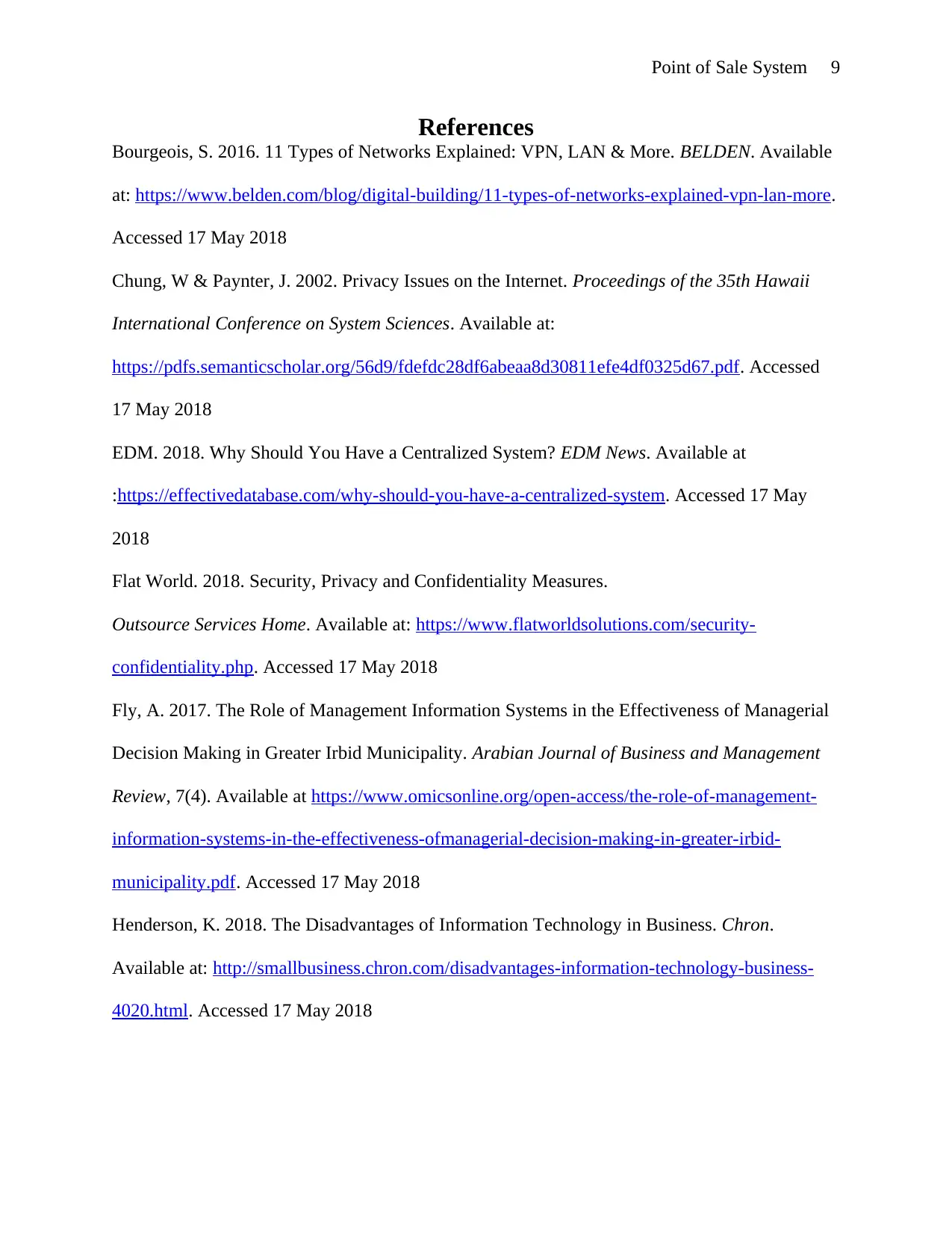
Point of Sale System 9
References
Bourgeois, S. 2016. 11 Types of Networks Explained: VPN, LAN & More. BELDEN. Available
at: https://www.belden.com/blog/digital-building/11-types-of-networks-explained-vpn-lan-more.
Accessed 17 May 2018
Chung, W & Paynter, J. 2002. Privacy Issues on the Internet. Proceedings of the 35th Hawaii
International Conference on System Sciences. Available at:
https://pdfs.semanticscholar.org/56d9/fdefdc28df6abeaa8d30811efe4df0325d67.pdf. Accessed
17 May 2018
EDM. 2018. Why Should You Have a Centralized System? EDM News. Available at
:https://effectivedatabase.com/why-should-you-have-a-centralized-system. Accessed 17 May
2018
Flat World. 2018. Security, Privacy and Confidentiality Measures.
Outsource Services Home. Available at: https://www.flatworldsolutions.com/security-
confidentiality.php. Accessed 17 May 2018
Fly, A. 2017. The Role of Management Information Systems in the Effectiveness of Managerial
Decision Making in Greater Irbid Municipality. Arabian Journal of Business and Management
Review, 7(4). Available at https://www.omicsonline.org/open-access/the-role-of-management-
information-systems-in-the-effectiveness-ofmanagerial-decision-making-in-greater-irbid-
municipality.pdf. Accessed 17 May 2018
Henderson, K. 2018. The Disadvantages of Information Technology in Business. Chron.
Available at: http://smallbusiness.chron.com/disadvantages-information-technology-business-
4020.html. Accessed 17 May 2018
References
Bourgeois, S. 2016. 11 Types of Networks Explained: VPN, LAN & More. BELDEN. Available
at: https://www.belden.com/blog/digital-building/11-types-of-networks-explained-vpn-lan-more.
Accessed 17 May 2018
Chung, W & Paynter, J. 2002. Privacy Issues on the Internet. Proceedings of the 35th Hawaii
International Conference on System Sciences. Available at:
https://pdfs.semanticscholar.org/56d9/fdefdc28df6abeaa8d30811efe4df0325d67.pdf. Accessed
17 May 2018
EDM. 2018. Why Should You Have a Centralized System? EDM News. Available at
:https://effectivedatabase.com/why-should-you-have-a-centralized-system. Accessed 17 May
2018
Flat World. 2018. Security, Privacy and Confidentiality Measures.
Outsource Services Home. Available at: https://www.flatworldsolutions.com/security-
confidentiality.php. Accessed 17 May 2018
Fly, A. 2017. The Role of Management Information Systems in the Effectiveness of Managerial
Decision Making in Greater Irbid Municipality. Arabian Journal of Business and Management
Review, 7(4). Available at https://www.omicsonline.org/open-access/the-role-of-management-
information-systems-in-the-effectiveness-ofmanagerial-decision-making-in-greater-irbid-
municipality.pdf. Accessed 17 May 2018
Henderson, K. 2018. The Disadvantages of Information Technology in Business. Chron.
Available at: http://smallbusiness.chron.com/disadvantages-information-technology-business-
4020.html. Accessed 17 May 2018
⊘ This is a preview!⊘
Do you want full access?
Subscribe today to unlock all pages.

Trusted by 1+ million students worldwide
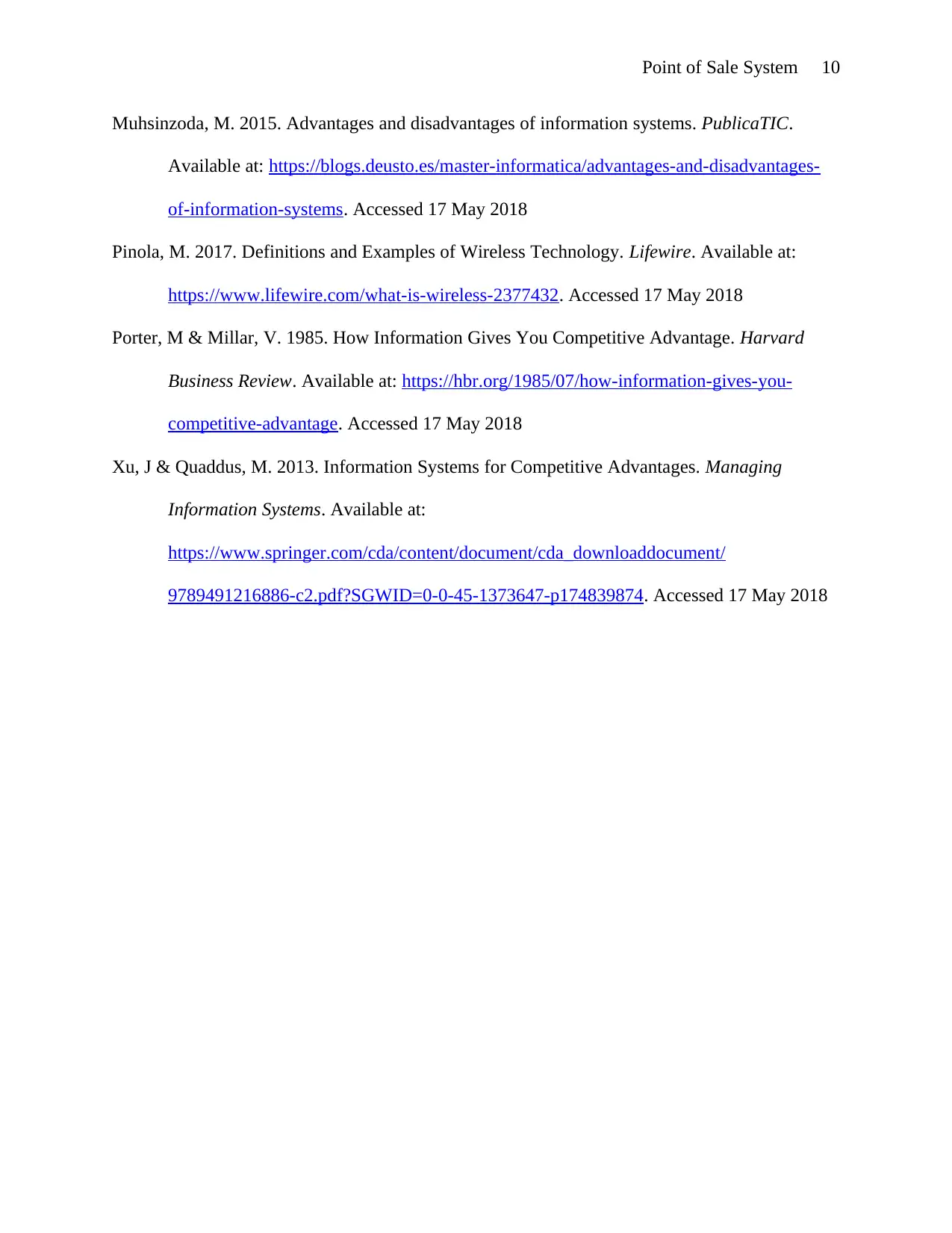
Point of Sale System 10
Muhsinzoda, M. 2015. Advantages and disadvantages of information systems. PublicaTIC.
Available at: https://blogs.deusto.es/master-informatica/advantages-and-disadvantages-
of-information-systems. Accessed 17 May 2018
Pinola, M. 2017. Definitions and Examples of Wireless Technology. Lifewire. Available at:
https://www.lifewire.com/what-is-wireless-2377432. Accessed 17 May 2018
Porter, M & Millar, V. 1985. How Information Gives You Competitive Advantage. Harvard
Business Review. Available at: https://hbr.org/1985/07/how-information-gives-you-
competitive-advantage. Accessed 17 May 2018
Xu, J & Quaddus, M. 2013. Information Systems for Competitive Advantages. Managing
Information Systems. Available at:
https://www.springer.com/cda/content/document/cda_downloaddocument/
9789491216886-c2.pdf?SGWID=0-0-45-1373647-p174839874. Accessed 17 May 2018
Muhsinzoda, M. 2015. Advantages and disadvantages of information systems. PublicaTIC.
Available at: https://blogs.deusto.es/master-informatica/advantages-and-disadvantages-
of-information-systems. Accessed 17 May 2018
Pinola, M. 2017. Definitions and Examples of Wireless Technology. Lifewire. Available at:
https://www.lifewire.com/what-is-wireless-2377432. Accessed 17 May 2018
Porter, M & Millar, V. 1985. How Information Gives You Competitive Advantage. Harvard
Business Review. Available at: https://hbr.org/1985/07/how-information-gives-you-
competitive-advantage. Accessed 17 May 2018
Xu, J & Quaddus, M. 2013. Information Systems for Competitive Advantages. Managing
Information Systems. Available at:
https://www.springer.com/cda/content/document/cda_downloaddocument/
9789491216886-c2.pdf?SGWID=0-0-45-1373647-p174839874. Accessed 17 May 2018
1 out of 10
Related Documents
Your All-in-One AI-Powered Toolkit for Academic Success.
+13062052269
info@desklib.com
Available 24*7 on WhatsApp / Email
![[object Object]](/_next/static/media/star-bottom.7253800d.svg)
Unlock your academic potential
Copyright © 2020–2025 A2Z Services. All Rights Reserved. Developed and managed by ZUCOL.



